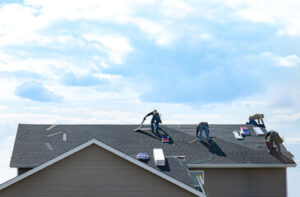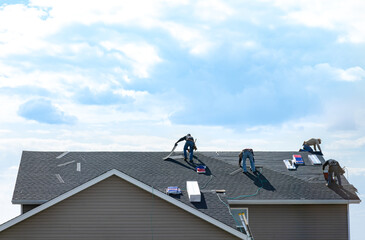A roof is a complex structure that requires regular maintenance. This will help avoid expensive repairs down the road.
Roofing maintenance can include checking for water stains in ceilings, which indicate that the roof is leaking. They can also look for shingles that are cracked, bent, or missing. Visit https://www.northportflroofing.com to learn more.
Maintenance should also include examining the flashing around chimney areas, dormers and vent pipes. Faulty flashing can let in rain which will rot the wood.
The roof flashing is a crucial part of the roofing system that is responsible for keeping water out of your home. It seals the gap between the roof sheathing and the wall cladding, eliminating the seam that would otherwise cause leakage and rot.
The flashing is a strip of metal that surrounds chimneys, skylights, vents, and other roof penetrations. It can be hard to see unless you are on the roof, so it is important to perform regular inspections from the ground and from within your attic. If you notice any cracked, chipped or missing flashing, have it replaced immediately to prevent leaks and rot.
Flashing can be made of a variety of materials, including aluminum, galvanized steel, or copper. The best choice depends on the location of the flashing and the surrounding climate. For example, copper is more prone to corrosion in cold climates than aluminum. Galvanized steel can rust in hot, humid climates. Check the flashing to ensure that it is securely fastened and in good condition. Nails and screws can wiggle loose over time, especially in high winds. Check the flashing for any raised nails or screws and re-tighten them if necessary.
You should also examine the flashing at the areas where walls meet the roof. A correctly-installed step flashing and a flashing diversion or deflector can help keep water away from these high-risk areas, protecting the wall cladding and foundation from moisture intrusion. Home inspectors often note that flashing has been incorrectly installed or is missing at these high-risk areas.
If your roof’s flashing is severely damaged, leaking or corroded, consider hiring professional roofers to assess the extent of the problem and recommend comprehensive repairs. They have the tools and safety equipment to conduct a thorough inspection from the top of the roof, which is impossible to do using binoculars or a window. They can also remove ice dams with commercial steaming equipment that is safer and more effective than manual removal techniques. A professional can also repair cracks and holes in the flashing, and re-caulk the joints to ensure a secure, weatherproof seal.
Trim Tree Branches
Branches that are too close to your roof can cause damage during heavy storms or simply get in the way of routine yard maintenance. Keeping your trees properly pruned on an annual basis prevents branches from falling on your home and protects against damage caused by wind, rain and debris.
Trimming your tree limbs properly promotes the health of the plant and improves its appearance as well. Proper pruning techniques include removing dead or diseased branches, thinning and reducing height (crown lifting). Branches that rub together should also be removed, as this creates an entry point for insects and other pests.
When trimming a branch, start on the underside and travel about 18 inches up the side of the branch. Locate what’s called the branch collar, which is a swelled area of bark at the base of the limb. This can be hard to see on some species, but usually is a ridge or circle of bark just above the limb itself. Make your first cut slightly outside of the collar, and then a second cut just inside the collar to remove the stub.
This approach allows the wound to compartmentalize naturally and reduces the risk of fungus infections or decay spores entering through the stem. Wounds that are too flush with the parent stem or left exposed are prone to rot and may compromise the health of the entire tree.
A good rule of thumb for deciding when to prune is: don’t remove more than 25% of a tree’s canopy in any one year. Too much removal at once can deprive the tree of vital energy, and can also encourage lots of vigorous upright growth that can weaken the tree.
Aim for a smooth, well-shaped cut that doesn’t leave stubs. This will help the tree heal properly and resist future rot. Using sharp tools, like a handsaw or pruning shears, is essential to getting clean cuts. Dull blades can do excessive bark damage and cause harmful rips that expose the underlying wood to rot and insect infestation. Always wear a pair of protective gloves when pruning.
Clean the Gutters
Keeping your gutters free of leaves, sticks, and other debris is essential to keeping rainwater flowing away from the roof. Clogged gutters can lead to water seeping under the shingles, behind the siding, and into the foundation of the house. This can result in expensive roofing and foundation repairs. You should clean your gutters at least twice a year, or more frequently if you live in an area that experiences frequent storms.
One of the most common ways to clean a roof is to use a ladder to manually remove debris from the gutters with a metal rake or a hand-held brush. This is a messy job but is relatively safe and can be done on dry, clear days. Be sure to use a ladder that can support your weight, and place it in a stable spot. It is also a good idea to have a spotter at the base of the ladder to help steady it and keep you from falling off of the roof.
If you are comfortable using a ladder, another way to clean the gutters is to use a garden hose with a gutter-cleaning attachment (a rigid tube with a curved end). This lets you stand on the ground instead of on the ladder and blow out the entire gutter with water. This method is effective but messy and can spray water, leaves, and twigs in every direction. You should wear safety goggles while doing this work.
Another option is to use a wet/dry vacuum extension kit, which allows you to vacuum out your gutters from the ground. You can find these kits online or at most hardware stores. They can be especially helpful if you have an older gutter system that is not fully aluminum and may have some rust holes.
The best solution is to hire a professional roof maintenance company to perform this important task. They have the equipment to reach even the highest rooftops safely and will be able to identify and fix any problems before they become worse. While it is not recommended to walk on the roof, these professionals will be able to do a complete inspection of the shingles and other features of your roof while they are cleaning the gutters.
Check the Shingles
The shingles are your roof’s first line of defense against the elements. It is a good idea to inspect them for damage, especially after bad storms, because it doesn’t take long for small issues to become major problems and costly repairs.
A roofer can spot signs of shingle damage like missing or lifted shingles, as well as granule loss (texture that indicates the shingles are wearing down due to age and weather). These problems leave your home exposed to water leaks. It is also important to check that the shingles are properly aligned and that they overlap each other by at least 1/2 inch.
If the shingles are loose, it will allow moisture to seep into the attic and other areas of your house. This is a sign that your roof needs to be replaced or repaired.
A properly installed and maintained shingle roof will provide years of protection for your home and the people inside. If you are concerned that your shingle roof isn’t doing its job or you have noticed damage, call a roofing contractor as soon as possible for an inspection and repairs.
In addition to examining your shingles, it is a good idea to look at the flashing around chimneys, sunroofs and vent pipes. This is where rust and other damage can occur. It is also a good idea to look at the eaves and soffit for dry rot, which can cause damage to your gutters and roof.
It is also a good idea to regularly clean your gutters, ensuring that they are not blocked or clogged with leaves or other debris. Clean gutters are essential for directing water away from your roof and home.
When you have finished checking the flashing, shingles and gutters, make sure to examine the underside of your roof for any signs of moss or lichen buildup. If you notice any, you should apply a moss killer, which is available in liquid form and can be applied to the roof surface. It is a good idea to periodically trim trees that overhang your roof to prevent them from catching branches and falling on the shingles.


